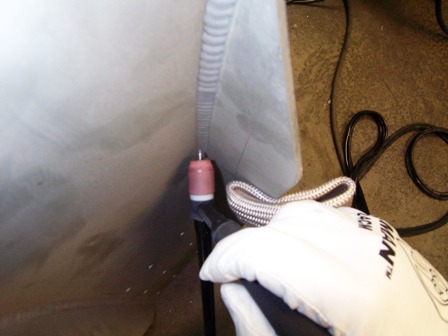How to Tig Weld Using the "Lay Wire" Method
"lay wire means you leave the wire in the puddle!.. "
Dip keyhole technique for roots
Watch the video and learn how to Tig weld with the "lay wire" tig welding technique...
This Tig Welding Technique is called "lay wire" by some people (especially Hobart training materials) because the tig welding rod is held in the puddle all the time and is never dipped in and out. The tig torch electrode is walked over the tip of the rod and the end result is a pretty weave that looks somewhat like boot laces. So whats the problem?
Most of the time, this tig welding technique works great. Pipefitters and boilermakers use it all the time to weld pipe, tubes, especially socket welds.
But there are situations where it does not work well at all.
Like tig welding aluminum or magnesium... and Thin Tee joints of any kind in the .032-.070" thickness range.
If you try to use the lay wire technique on a thin titanium tee joint like is required for aerospace welding tests, you will get lack of fusion in the root every time.
For Carbon and Stainless Steel pipe, the lay wire technique has proven its worth in the field with millions of x ray tests over the years.
The joint in the video is a 1/4" wall thickness 1 1/4" carbon steel tubing.
I ground a 35 degree bevel on each piece so I could have groove to fill in that would work ok with lay wire welding.
For the root pass, I gapped it 3/32" . I used 1/16" er70s-2 filler rod for the root pass ( i keyholed and dipped the root).
Normally, I would use a bigger rod for the root but I only had 1 3/32" rod and needed that for the rest of the video to show the lay wire welding.
About 75-90 amps on the root pass and 100-115 amps for the weave passes did the trick.
a #7 tig cup with 3/32" 2% lanthanated tungsten and 20 cfh of argon.
The tungsten electrode has to be extended to just the right length to keep the arc length tight. Too long an arc and the tip of the weld wire will get hot too far back and ball up and just blob into the weld. Keeping a tight arc length like you see in the video, lets the rod flow into the puddle nicely and precisely.
Using the Lay Wire Technique along with "walking the cup" is a very popular way to weld pipe but the smaller the pipe, the harder is is to walk the cup.
I remember taking a welding test they called a "rifle barrel" test because it resembled the a barrel of a gun...you could not even fit a pencil in the hole....imagine trying to walk the cup around a tube that small in the 6G position....not good.
Thats when you really need a
TigFinger .
exit how to tig weld visit tig finger heatshield demo page
















